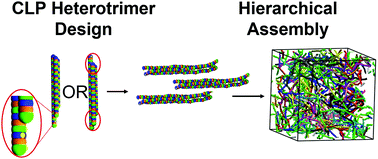Impact of collagen-like peptide (CLP) heterotrimeric triple helix design on helical thermal stability and hierarchical assembly: a coarse-grained molecular dynamics simulation study†
Abstract
Collagen-like peptides (CLP) are multifunctional materials garnering a lot of recent interest from the biomaterials community due to their hierarchical assembly and tunable physicochemical properties. In this work, we present a computational study that links the design of CLP heterotrimers to the thermal stability of the triple helix and their self-assembly into fibrillar aggregates and percolated networks. Unlike homotrimeric helices, the CLP heterotrimeric triple helices in this study are made of CLP strands of different chain lengths that result in ‘sticky’ ends with available hydrogen bonding groups. These ‘sticky’ ends at one end or both ends of the CLP heterotrimer then facilitate inter-helix hydrogen bonding leading to self-assembly into fibrils (clusters) and percolated networks. We consider the cases of three sticky end lengths – two, four, and six repeat units – present entirely on one end or split between two ends of the CLP heterotrimer. We observe in CLP heterotrimer melting curves generated using coarse grained Langevin dynamics simulations at low CLP concentration that increasing sticky end length results in lower melting temperatures for both one and two sticky ended CLP designs. At higher CLP concentrations, we observe non-monotonic trends in cluster sizes with increasing sticky end length with one sticky end but not for two sticky ends with the same number of available hydrogen bonding groups as the one sticky end; this nonmonotonicity stems from the formation of turn structures stabilized by hydrogen bonds at the single, sticky end for sticky end lengths greater than four repeat units. With increasing CLP concentration, heterotrimers also form percolated networks with increasing sticky end length with a minimum sticky end length of four repeat units required to observe percolation. Overall, this work informs the design of thermoresponsive, peptide-based biomaterials with desired morphologies using strand length and dispersity as a handle for tuning thermal stability and formation of supramolecular structures.



 Please wait while we load your content...
Please wait while we load your content...
